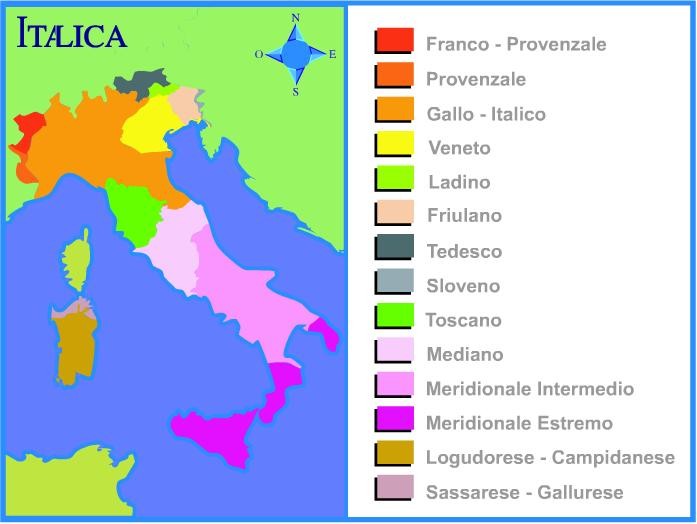Dialects of Italy
The dialects of modern Italian all have their roots in the spoken form of Latin (Vulgar Latin), in use throughout the Roman Empire. Vulgar Latin had, no doubt, its own local peculiarities before the fall of the Empire. The political instability that followed Roman rule kept Italy from re-uniting as a nation until the nineteenth century. This long period of fragmentation and the fact that Classical Latin was preferred as the international language of study allowed the various modes of speech to develop on their own until they could almost be called separate languages. Many dialects are, in fact, unintelligible with each other.
With the political reunification of the peninsula and the degree of travel and relocation that began to take place, the need for a national language became all the more urgent. This need was met by the literary language, which had evolved as a standardized form of Florentine. Today, thanks to aggressive education programs, the literary language is used throughout the country for law, business, and education. The dialects are finding themselves relegated to home use, or between close neighbors in urban neighborhoods and villages.
There are two major groups of Italian dialects, excepting the Sardinian group which is considered another language entirely. These two groups are separated by the Spezia-Rimini line, named for the two cities near which it passes; the line runs east-west across the peninsula, for the most part following the border between Tuscany and Emilia-Romagna, then cutting into the Marches. Above the divide lie the Northern (Settentrionale) dialects; below it the Central-Southern (Centro-Meridionale) dialects.
The Septentrional or Northern dialects in turn are divided into two main groups: the largest of these geographically is the Gallo-Italic group, encompassing the regions of Liguria, Piedmont, Lombardy, and Emilia-Romagna, as well as parts of Trentino-Alto Adige. It is named for the Gauls which once inhabited this part of Italy, and who, it seems, left traces of their Celtic speech in the modern dialects. Next largest is the Venetic group, whose borders loosely follow the region of Veneto.
The Central-Meridional dialects are of four distinct groups. The Tuscan group occupies an area roughly approximating that of the region of Tuscany. To the south are the Latin-Umbrian-Marchegian dialects, which occupy the northern half of Latium (including Rome), most of Umbria and some of the Marches. These two are also sometimes grouped together as the Central dialects. Directly below these are the Meridional dialects, of two major types. The Intermediate Meridional dialects occupy the bottom half of the peninsula, including the regions of southern Lazio, Abruzzi, Molise, Campania, Basilicata, and parts of Apulia. The tips of Calabria and Apulia, however, together with Sicily, delineate the Extreme Meridional dialects.
Within the political boundaries of Italy are two other Romance languages. Ladino is spoken in the extreme north-east of Italy; a Friulian type in Friulia, and a Dolomitic type in the Dolomite mountains. Sardinian, spoken on the island of Sardinia, is divided into Logudorese-Campidanese and Sassarese-Gallurese. (Further information on Sardinian is available on the Sardinian Language and Culture Page.)
Dialects of Italian are also spoken outside of the political boundaries of Italy. The Istrian dialects are restricted to the southwestern portion of the peninsula of Istria in modern day Croatia. These, together with the Venetic dialects spoken just to the north, are of the Septentrional type. Corsican, on the French island of Corsica, falls under the Central-Meridional group.
Characteristics of the Urban Dialects
Milan
The dialect of Milan, or Milanese, is classified as a Septentrional dialect, specifically in the Gallo-Italic sub-group. As in German and French, the front vowels ö and ü are present: fök (fuoco), kör (cuore), brüt (brutto).
Venice
Venetian is, like Milanese, a Septentrional dialect; but falls under a different sub-group: the Venetic. Unlike Milanese, Venetian does not have the "gallic" vowels ö and ü and in this respect bears some resemblances to the Tuscan dialects to the south. The verb xe serves in the third person for the standard è (is), and sono (are). Double consonants are to some extent singularized in Venetian: el galo (il gallo), el leto (il letto); note also the use of the masculine article el (il).
Florence
The Tuscan dialects, including Florentine, are the most conservative of the Italian dialects. An example of its conservatism is seen in the retention of the consonant cluster -nd- as in quando; in most dialects, this cluster is leveled to -nn-, e.g. quanno. This feature is also true of modern standard Italian, which is based on the literary Florentine that Dante and Petrarch wrote in. Nevertheless, there are some local peculiarities that differentiate Florentine from Standard Italian. The most striking is the so-called "gorgia Toscana", the throaty aspiration of stops that is thought to have a root in Etruscan phonology. The gorgia has a sound like the Greek chi or German ch, similar to a raspy English h. Thus we hear chasa for casa (house), ficho for fico (fig); a similar aspiration also occurs before medial t: andatho or andaho (andato), datho or daho (dato).
Rome
In Romanesco we see a few deviations from standard Italian. Firstly, -nd- is commonly leveled to -nn-: thus, quanno (quando), monno (mondo). The standard gl (similar to the -lli- in English million) is realized as j (pronounced like the English y): vojo (voglio); maja (maglia). We also see r substituted for l in some positions: er core (il cuore); and vorta (volta).
Naples
The Neapolitan dialect, Napoletano, is the best known dialect aside from the standard language, due to its heavy use is popular Italian songs. It is a typical Meridional dialect, in that initial chi- takes the place of pi-; thus chiù (più), and chiove (piove). Final, unaccented vowels are often pronounced as a undifferentiated vowel, similar to the English schwa. The articles (excepting ll') in Napoletano are clipped to bare vowels: 'o libbro (il libro), 'a casa (la casa), 'e piatte (i piatti).


